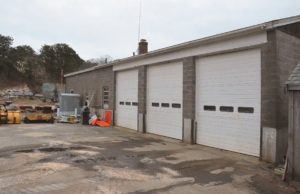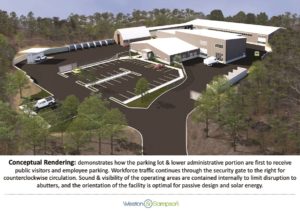PROVINCETOWN — Dept. of Public Works Director Rich Waldo served the town for exactly 10 years before leaving to take the town administrator job in Wellfleet. In that time, he oversaw the phased resurfacing of Commercial Street, the redesign of Shank Painter Road, and the development of a $75-million plan to expand the town’s sewer system to nearly every property in Provincetown.
Last month, Waldo made a final pitch to the select board for something he saw tabled throughout those 10 years: a plan for a new DPW facility.
“I wanted to get this out and articulate it before I leave,” said Waldo. “We really want to start the progressive steps, and maybe it won’t be built in three years, but it will be built in 10 years.”
The current DPW building on Race Point Road just north of Route 6 was built in 1950 out of cinderblocks. It is essentially a garage — it has a cesspool, no insulation, and no fire alarms or sprinklers, according to a needs assessment and site analysis done by the municipal contracting firm Weston and Sampson. What used to be the garage bays hold equipment, tools, and workspaces, while vehicles are mostly stored outside. DPW administrators work from a different building, the Veterans Memorial Community Center on Winslow Street.

In 2009, the town set out on a plan to build a combined DPW facility and police station at Race Point Road, Waldo recounted, but that effort ended at spring town meeting in 2012.
“In 2012, there was an outcry because of the project’s size and cost and, basically, the assumption that the town couldn’t afford it at the time,” Waldo said. “The number was maybe $17 million,” he said, “a bargain by today’s standards.”
The need for a police station seemed more pressing. “At that time, we were asked to step aside and pave the way for the police station project, and we said OK,” Waldo said.
It took 10 years for a new police station location and design to be approved and funded. Town meeting authorized $8.6 million for a police station in 2017, voted down a $3.9-million supplemental authorization in 2019, and approved an $8.5-million supplemental authorization in 2022, for a combined total of $17.1 million to be spent. The new police station will be located at the intersection of Jerome Smith Road, Shank Painter Road, and Route 6.
The Weston and Sampson presentation at the select board meeting outlined a pair of buildings that comprise 45,000 square feet, with more than half the total area dedicated to indoor storage of vehicles. Nine thousand square feet of office and employee space and seven thousand square feet for a vehicle maintenance bay make up most of the rest of the project. Weston and Sampson offered a “post-pandemic” price range for construction costs of $506 to $553 per square foot, and a total project cost of $29 to $31 million.

The select board was broadly supportive, with the caveat that a plan is needed to sequence the town’s upcoming major projects.
“All these capital projects — this is a result of kicking the can down the road,” said select board member Leslie Sandberg. “There’s delayed maintenance and delayed planning. This is not to blame anyone, but right now we are here. You guys deserve a new facility, and we just have to figure out what the timing is.”
“We need to take a big-picture look at this,” said select board member Louise Venden. “You have people on your staff who can’t live here. We need to invest millions of additional dollars in housing, in addition to $30 million for a new fire facility, $30 million for a DPW garage, and $75 million for sewer. And that ocean is creeping up on us.
“We need to put all the cards on the table and figure out how and when we can do all these things,” Venden said.
Future Projects
In an interview with the Independent, Waldo discussed some of the town’s upcoming projects.
“The town is extremely good at getting grant funds,” said Waldo. “These funding agencies need to look good on their end, and when you execute a project very well, it reflects well on them. When these agencies see Provincetown applying, they’re like, ‘Oh, let’s try to get them funded.’ ”
Waldo credited town staff with that success. “There’s so much that people don’t see, and a lot of staff time that people don’t recognize,” he said.
The upcoming improvements to Shank Painter Road are Waldo’s “baby,” what he called “a really beautiful project that’s going to have such an impact to that area.”
That project, he said, is “all set up to go, the funding has been secured; I just won’t be in the driver’s seat to see it happen.”
The state is funding the Shank Painter Road project, which will add bike lanes and other improvements, turn the intersection with Route 6 into a rotary, and replace the two inbound traffic lanes of Route 6 from Herring Cove Beach to Shank Painter with a bike and pedestrian path. The town is now studying whether the two southern lanes of Route 6 can also be removed from Shank Painter Road to Conwell Street.
The town owns the land under the roadbed, and, in some places, it owns the adjacent parcels as well. The new police station will be sited on some of this land, and town officials have floated ideas for other parts of it, including a wastewater substation, a fire substation, and a potential new housing project.
The town’s wastewater leaching fields are in these town-owned parcels as well, but Waldo said it’s feasible to move all of them to Motta Field. He estimates moving the effluent beds to Motta Field will cost about $2.5 million.
“It’s really not a super challenging project — it’s just pipe,” he said. “The effluent that comes out of there is very clean, some say potable, but we have no volunteers to try it,” Waldo added.
In addition to these parcels, the town is studying the Veterans Memorial Community Center building for redevelopment. That is where several town departments, including DPW, are currently headquartered.
Waldo said the costs of temporarily relocating these departments during a full-blown reconstruction of the VMCC would be large — “probably an extra $5 million.” He pointed to the nearby Grace Hall parking lots and said housing over parking, or housing next to an elevated parking structure, might be cheaper than tearing down the VMCC.
Waldo leaves with some things still on his wish list. He lamented how much land is owned by the state Div. of Fish and Wildlife.
“I wish the process wasn’t so cumbersome to try to get that back,” said Waldo. “It’s huge swaths of land down by Howland Street. If we could just scab off a little piece somewhere for a cluster development, make a land swap, that would be our greatest defense for housing.”
